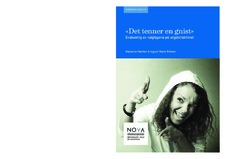| dc.description.abstract | In 2012, elective subjects were reinstated in Norwegian lower secondary school in an effort to make lower secondary school more motivational, practical and varied for the pupils. NOVA has assessed whether the reinstatement of elective subjects helps reach this goal. The study is financed by The Norwegian Directorate for Education and Training. The report is based on interviews with pupils, teachers and school leaders at 12 lower secondary schools in the north, west and east of Norway. Some classes have been observed. We also employ survey data from 220 school leaders. Main findings The elective subjects are very popular amongst pupils, teachers and leaders. Many pupils choose the same elective subjects, but boys and girls choose differently. In many lower secondary schools the elective subjects receive little economic resources and equipment, but teachers’ enthusiasm often play a key role. Few teachers and leaders use or know about national guidelines and resources. Teachers and leaders do not perceive mixed classes as problematic. Teachers and leaders think marking is difficult and problematic in the elective subjects. The elective subjects seem to be «kindling a flame» of school motivation in the pupils. Popular elective subjects The elective subjects are very popular amongst pupils, teachers and leaders. Teachers claim that the subjects “kindle a flame” of school motivation in the pupils – and in themselves. The elective subjects are popular mainly because they are practical and because they present a break from ordinary subjects. Pupils, teachers and leaders alike think the elective subjects enhance school motivation. Some pupils, who are not theoretically inclined or interested in physical activity, may struggle also in the elective subjects. Pupils with little school motivation and a low academic level seem to experience less well being in the elective subjects than other pupils. The choices of elective subjects There are 14 different elective subjects, but most of the pupils attend only three: Physical activity and health, Production for hall and stage, and Design and redesign. It is chiefly the teachers’ interest and qualifications that determine which subjects are offered, but school leaders also aim to take pupils’ choices into account when deciding which subjects to offer. Pupils’ choices are shaped by the school’s official information about the subject, rumours about teachers and subjects, their friends’ choices, and where they are most likely to achieve good grades. Boys and girls also choose differently. Within the subjects, the pupils’ possibilities for choosing tasks vary. Resources In many lower secondary schools, the elective subjects have little economic resources and equipment, but teachers’ enthusiasm often play a key role. Although lack of finances may be a problem, most find that they manage to make the elective subjects varied, motivational and practical, largely because of the teachers’ interest, creativity, and enthusiasm. Most teachers think that they have sufficient competencies to teach the elective subjects. Subject curriculum The same subject is taught in different ways in different schools. It is mostly the teachers who develop the subject curriculum, and the shape each elective subject takes in different schools seems to be influenced by the particular teachers’ interests and competencies. Many find the core curriculum to be highly general, which may lead to difficulties in developing the subject curriculum as well as in marking. Few teachers and leaders use or know about national guidelines and resources. Teachers are generally conscious about making the subjects practical and varied. Mostly, the pupils also find the subjects practical and varied. That the subjects are meant to be interdisciplinary is rarely seen as a challenge for the teachers. Mixed classes Pupils can choose a new elective subject each year, or stay with the same for several years. The elective subjects may therefore have classes with a mix of pupils of different levels and age in the same group. Teachers and leaders do not perceive mixed classes as problematic. Some view mixed groups as a potential strength for the pupils, both academically and socially. Difficult marks Whereas the pupils mostly appreciate marks in the elective subjects because the prospect of being marked gives them a goal and a possibility to better their average mark, teachers and leaders think marking in the elective subjects is difficult and problematic. They are commonly worried for possible consequences, such as that marking may work against the aim of varied, motivational and practical elective subjects. Some teachers and leaders are more positive, and think that marks could secure the elective subjects’ legitimacy. Many think that pass/not pass would be more a more appropriate way to mark the elective subjects. | en |
